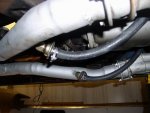Re: PCV Tubes route to the flame arrestor in a boat???
It all started as a simple question, thats all, some people tried to help me, some assumed I would screw up my boat, some tell me to fix other things without even seeing my boat. When I post a question looking for a direct answer, I expect a direct answer, not sarcasim, opinions, lengthly replies having nothing to do with my question and belittling. What I havent told anyone is that I spent 6 years as an engine builder by trade and have vast experiance reservicing truck gas and diesel engines. You guys may know way more about boats than me, but when it comes to engines, I'm good. I was only curious what the reason for routing the tubes to the carb were and if there was a kit to rout them thru the exhaust. 30 posts later and you know what, there is a kit to rout them thru the exhaust. Of course a majority of the people willing to offer up their stupid opinions did not know this kit even existed but were quick to type an answer. I will be sure to use this forum on a limited basis and stear clear of the engine section going forward. IF you know the answer to the OP's question, answer it, if you dont know, refrain from typing nonsence. As for the few people that truly tried to help me, I really do apreciate it.
Good day.
Ayuh,.... This is an open forum, so you'll get all kinds of answers from all kinds of folks...
Ya just gotta skip over the answers you don't like...
It's the very nature of forums,...
ALL forums...
As for this Kit,... Read the write up on it,...
It Ain't for Boats,...
It ain't even for a Street car,... It's for
RACE cars...
"*NOTE: Cannot be be used on cars w/ mufflers"
If it can't be used on a car with a muffler, it sure as 'ell won't work on a choked up boat exhaust...
Nobody is belittling you, 'n yer engine knowledge should lead ya to the answers you've been given...
Yer boat, Ain't a Race car,...
'n a Boat doesn't react to Race motor mods very well...
Actually, if Race motor mods are done on Boat motors,...
Anchors are the usual results....
If ya think it's so easy to pull off,... Go for it....
We'll all be here, waitin' to hear yer results.....
Btw,... If yer boatin' in the Saltwater off Long Island,...
Yer venting is gonna cause All kinds of issues...
That kit will turn to rusty dust in no time, flat...






















